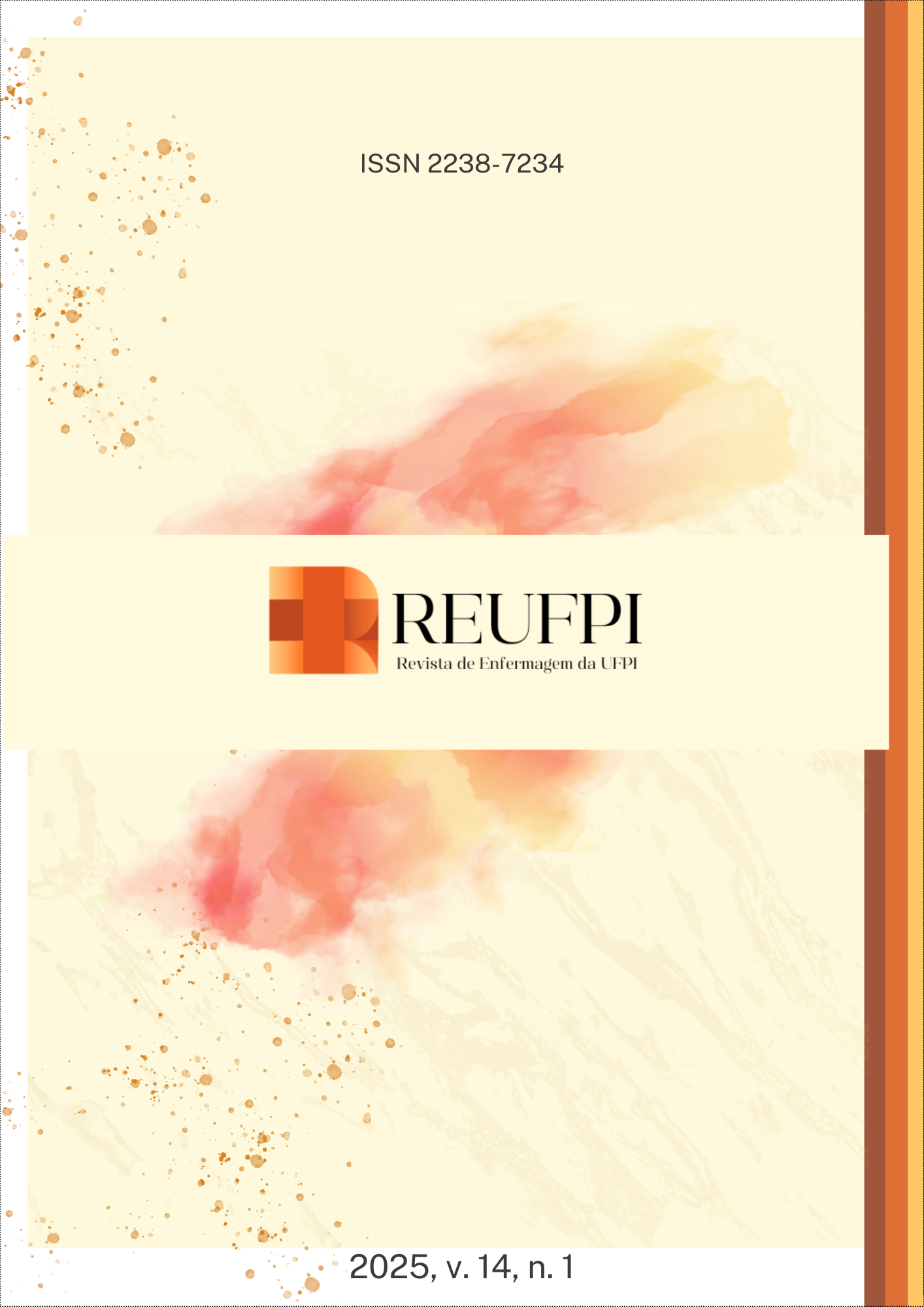Big data e machine learning na previsão de ideação suicida: revisão integrativa
DOI:
https://doi.org/10.26694/reufpi.v14i1.6249Palavras-chave:
Big Data, Aprendizado de Máquina, Ideação Suicida, Saúde MentalResumo
Objetivo: Analisar, na literatura, a aplicação de técnicas de Machine Learning e Big Data para predição da ideação suicida em diferentes populações. Métodos: Revisão integrativa, conduzida conforme o modelo proposto por Whittemore e Knafl, no mês de outubro de 2024. Dois revisores independentes realizaram a busca nas bases de dados MEDLINE/PubMed, Web of Science e PsycINFO. Foram incluídos estudos primários que abordaram o uso de Big Data e Machine Learning na previsão da ideação suicida, sem restrições quanto ao idioma ou à data de publicação. A apresentação dos resultados seguiu as diretrizes do protocolo PRISMA. Resultados: Foram selecionados dez estudos para compor esta revisão, que demonstraram o potencial de Big Data e Machine Learning na identificação de padrões de risco para ideação suicida em diversos grupos, como minorias sexuais e de gênero, estudantes, pacientes psiquiátricos, pacientes que sofreram acidente vascular cerebral, trabalhadores e a população em geral, com alta precisão preditiva. Realizados na Ásia e América do Norte, os estudos empregaram métodos variados de coleta e análise, destacando-se a random forest como técnica recorrente e potencialmente eficaz. Conclusão: O uso de Big Data e Machine Learning na saúde mental oferece avanços significativos na predição da ideação suicida.
Referências
Ministério da Saúde (BR). Suicídio (Prevenção). Brasília: Ministério da Saúde; 2024. Available from: https://www.gov.br/saude/pt-br/assuntos/saude-de-a-a-z/s/suicidio-prevencao.
Santos J, Pimentel FO, Méa CPD, Patias ND. Ideação suicida na adolescência e fatores associados. Arquivos Brasileiros de Psicologia. 2022; 74:e024. Doi:10.36482/1809-5267.ARBP-2022v74.19801
World Health Organization. Suicide worldwide in 2019: global health estimates. Geneva: World Health Organization; 2021. ISBN: 9789240026643.
Alves FJO, Fialho E, Araújo JAP, Naslund JA, Barreto ML, Patel V, Machado DB. The rising trends of self-harm in Brazil: an ecological analysis of notifications, hospitalisations, and mortality between 2011 and 2022. Lancet Reg Health Am. 2024;31:100691. DOI: 10.1016/j.lana.2024.100691.
Ministério da Saúde (BR). Boletim epidemiológico. Panorama dos suicídios e lesões autoprovocadas no Brasil de 2010 a 2021. Brasília: Ministério da Saúde, Secretaria de Vigilância em Saúde e Ambiente; 2024. Available from: https://www.gov.br/saude/pt-br/centrais-de-conteudo/publicacoes/boletins/epidemiologicos/edicoes/2024/boletim-epidemiologico-volume-55-no-04.pdf.
Barbosa SS, Rodrigues J, Guimarães GF, Lopes SMB. Aplicativos de celular na prevenção do comportamento suicida. SMAD, Rev Eletrônica Saúde Mental Álcool Drog. 2020;16(4):100-8. Doi: 10.11606/issn.1806-6976.smad.2020.167062
Oliveira LM de, Fernandes Junior LCC. Aplicabilidade da inteligência artificial na psiquiatria: uma revisão de ensaios clínicos. Debates em Psiquiatria [Internet]. 2020;10(1):14-25. DOI: 10.25118/2236-918X-10-1-2
Whittemore R, Knafl K. The integrative review: updated methodology. J Adv Nurs. 2005;52(5):546-553. Doi:10.1111/j.1365-2648.2005.03621.x
Page MJ, McKenzie JE, Bossuyt PM, et al. The PRISMA 2020 statement: An updated guideline for reporting systematic reviews. BMJ. 202;372(71). DOI: 10.1136/bmj.n71
Lei C, Qu D, Liu K, Chen R. Ecological Momentary Assessment and Machine Learning for Predicting Suicidal Ideation Among Sexual and Gender Minority Individuals. JAMA Netw Open. 2023;6(9):e2333164. doi:10.1001/jamanetworkopen.2023.33164
Shin S, Kim K. Prediction of suicidal ideation in children and adolescents using machine learning and deep learning algorithm: A case study in South Korea where suicide is the leading cause of death. Asian J Psychiatr. 2023;88:103725. doi:10.1016/j.ajp.2023.103725
Kim S, Lee K. The Effectiveness of Predicting Suicidal Ideation through Depressive Symptoms and Social Isolation Using Machine Learning Techniques. J Pers Med. 2022;12(4):516. Published 2022 Mar 22. doi:10.3390/jpm12040516
Bozzay ML, Hughes CD, Eickhoff C, Schatten H, Armey MF. Identifying momentary suicidal ideation using machine learning in patients at high-risk for suicide. J Affect Disord. 2024;364:57-64. doi:10.1016/j.jad.2024.08.038
Li TMH, Chen J, Law FOC, Li CT, Chan NY, Chan JWY, et al. Detection of Suicidal Ideation in Clinical Interviews for Depression Using Natural Language Processing and Machine Learning: Cross-Sectional Study. JMIR Med Inform. 2023;11:e50221. doi:10.2196/50221
Roy A, Nikolitch K, McGinn R, Jinah S, Klement W, Kaminsky ZA. A machine learning approach predicts future risk to suicidal ideation from social media data. NPJ Digit Med. 2020;3:78. Published 2020 May 26. doi:10.1038/s41746-020-0287-6
Hwanjin P, Lee K. A Machine Learning Approach for Predicting Wage Workers' Suicidal Ideation. J Pers Med. 2022;12(6):945. doi:10.3390/jpm12060945
Lee J, Pak TY. Machine learning prediction of suicidal ideation, planning, and attempt among Korean adults: A population-based study. SSM Popul Health. 2022;19:101231. doi:10.1016/j.ssmph.2022.101231
Lekkas D, Klein RJ, Jacobson NC. Predicting acute suicidal ideation on Instagram using ensemble machine learning models. Internet Interv. 2021;25:100424. doi:10.1016/j.invent.2021.100424
Song SI, Hong HT, Lee C, Lee SB. A machine learning approach for predicting suicidal ideation in post stroke patients. Sci Rep. 2022;12(1):15906. doi:10.1038/s41598-022-19828-8
Couronné R, Probst P, Boulesteix AL. Random forest versus logistic regression: a large-scale benchmark experiment. BMC Bioinformatics. 2018;19(1):270. doi: 10.1186/s12859-018-2264-5.
Ignatenko V, Surkov A, Koltcov S. Random forests with parametric entropy-based information gains for classification and regression problems. PeerJ Comput Sci. 2024 Jan 3;10:e1775. doi: 10.7717/peerj-cs.1775.
Gremsl T, Hödl E. Emotional AI: legal and ethical challenges. Information Polity. 2022;27(2):163-174.
Waring J, Lindvall C, Umeton R. Automated machine learning: Review of the state-of-the-art and opportunities for healthcare. Artif Intell Med. 2020 Apr;104:101822. doi: 10.1016/j.artmed.2020.101822.
Habehh H, Gohel S. Machine Learning in Healthcare. Curr Genomics. 2021 Dec 16;22(4):291-300. doi: 10.2174/1389202922666210705124359.
Downloads
Publicado
Como Citar
Edição
Seção
Licença
Copyright (c) 2025 Revista Enfermagem UFPI

Este trabalho está licenciado sob uma licença Creative Commons Attribution 4.0 International License.
Autores mantém os direitos autorais e concedem à REUFPI o direito de primeira publicação, com o trabalho licenciado sob a Licença Creative Commons Attibution BY 4.0 que permite o compartilhamento do trabalho com reconhecimento da autoria e publicação inicial nesta revista.

























